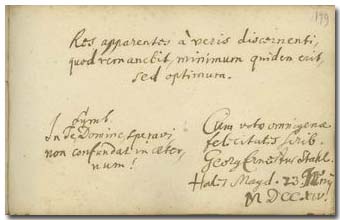
Res apparentes à veris discernenti, quod remanebit, minimum quidem
erit, sed optimum.
Symb[olum]. In Te, Domine, speravi non confundar in aeternum! *
Cum voto omnigenae felicitatis scrib[ebat] Georg Ernestus Stahl.
Halis Magd[eburgicae] 23 Junij MDCCXIV.
|
|
If you compare virtual things with real ones, the difference might
be small, but essential.
Motto: In thee, o Lord, do I put my trust; let
me never be ashamed! *
Wishing every best possible
Georg Ernest
Stahl
in Halle of Magdeburg, June 23, 1714
|
p.
179. Halle, June 23, 1714
Stahl, Georg Ernst
(1660-1734), German natural
scientist, physician, chemist
Georg
Ernst Stahl was born in Ansbach on October 21, 1660. He received a
deeply religious education. He studied in Jena, attending mostly
the lectures of Georg
Wolfgang Wedel (1645-1721). He graduated and taught here from 1783.
At the age of 27 he was appointed court physician of Johann Ernest
III (1664-1707), Prince of Saxon-Weimar. In 1693 Friedrich
Hoffmann (1660-1742), his former fellow student and then professor
of medicine at the recently founded university of Halle, invited
him the second ordinary professor of medicine. These two excellent
minds in a way distributed the disciples amongst themselves:
Hoffmann specialised mostly in the practical branches of medicine,
anatomy, surgery, physics and chemistry, while Stahl in
physiology, pathology, pharmacology, dietetics and botany. In 1716
Stahl was invited to Berlin as court physician of the Prussian
King; he beheld this office until his death. He was a reticent man
with an orthodox mind, who could not suffer contrary opinions. He
died in Berlin on May 14, 1734. Apart from practical medicine, he
also pursued theoretical scholarship. In his Jena lectures,
published by his students in 1720, he still professed the
principles of alchemy. Later he gradually recognised that metals
cannot be transformed into each other, and that the purpose of
chemistry is not only gold-making and healing. According to his
later definition, chemistry is the science – or art – of the
analysis and creation of compound materials. He published his
theory of phlogiston in 1697, but its real foundations were laid
in the appendix to a work of Johann
Joachim Becher (1635-1682) published in 1703. This theory, by
admitting a hypothetical material called "phlogiston" (Greek
phlogeos = burning) that flows from and into the materials in
transformation, had the virtue of explaining on a uniform platform
a large number of phenomena until then regarded as isolated, like
combustion, processes of metallurgy, fermentation, rottening,
respiration, as well as the innumerable independent experiences of
alchemists. This first uniform theory of chemical transformations
promoted the development of chemistry – interestingly, Carl Wilhelm Scheele (1742-1786),
the discoverer of oxygen, also belonged to its believers –, and it
was only substituted after a century by the modern theory of
oxidation-reduction processes proposed by Antoine Laurent Lavoisier (1743-1794).
In physiology Stahl occupied a middle position between earlier
theories of chemiatry (jatrochemistry) and modern mechanistic ones
with his "animist" thought: living organisms, which are typically composed of
water, oil and earth, are saved from decomposing and rottening by an
"anima" or "natura" as inner "principium movens", which, however,
clearly differs from conscious and immortal soul. According to
this theory, medicine has to activise these inner forces of
organism. Stahl had some 240 various publications. Some of his
principal works: Fundamenta chymiae dogmaticae &
experimentalis. Nürnberg, 1723. – Zymotechnia fundamentalis
sive fermentationis theoria generalis. Halle, 1697. – Joh.
Joachimi Beccheri … Physica subterranea profundam
subterraneorum genesin … ostendens … Specimen Becherianum
… subjunxit Georg. Ernestus Stahl. Leipzig, 1703. –
Experimenta, obsevationes, animadversiones … chymicae et
physicae. Berlin, 1731. – Schriften von der Natur … des
Salpeters, Frankfurt-Leipzig 1734. – De vera diversitate corporis
mixti et vivi … demonstratio. Halle, 1707. – Theoria
medica vera … Halle, 1708.
Georg
Ernst Stahl wrote his memento in the album of Ferenc Páriz Pápai
as a professor of Halle in 1714. Among his fellow professors it
was Michael Alberti, and among his students Georg Sigmund Liebezeit
of Sopron (Hungary) to write in the album (pp.
427,
351).
• ADB
XXXV 780 • BritHung • Jöcher • Michaud • MNL |

